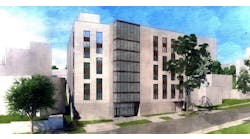With many schools and universities, the rush to expand technology has created a situation in which the desire to hurry has overwhelmed the need for solid planning. Pulling wire, drilling holes to connect technology equipment and using the Internet make for good conversation. However, such post-haste installations often fail to take into account the need for flexible raceway systems and cable management that will serve the building.
Good planning is the first essential ingredient for a long-term cable-management solution. This should always take place before technology equipment is selected. In fact, a technology plan that explains what role technology is going to play within the instructional and management system of the school is the first step. Only then can an effective raceway and cable-management system be designed to produce capacity for change, functional aesthetics and reliability.
A cable-management system should be easily adaptable to any expansion or change, while maintaining the ability to retrofit into upgraded systems. By selecting a system that can handle expansion and retrofitting with little or no service disruption, schools will assure maximum opportunities.
In high-capacity networks, wire management and protection are essential ingredients. Choosing the right cable-management system to route and protect wire is a critical first step in ensuring long-term network performance. Routing and protecting cable are only part of what a cable-management system should do. The astute network planner should look for a feature-rich system that can meet today's demands and tomorrow's uncertainties. The ultimate goal in seeking cable-management options should be finding a system that offers maximum protection and routing capabilities while still enabling rapid deployment in current — and future — network environments.
An informed choice
A cable-management raceway system provides organization, security and protection in a structured method of connecting, managing cable and distribution devices for voice, data, video networks and power. Cable management brings consistency, quality performance, longer life and less expense to a building network system. Cable management generally is handled through a variety of raceway systems.
Conventional “behind-the-wall” cabling does not provide the kind of fast, easy access required to support constantly changing technology requirements. To reconfigure this conventional cabling system, it is necessary to break into walls, pull cable and install the necessary devices. This is time-consuming, disruptive and costly. Fortunately, there is a better way to achieve cabling flexibility.
The most common methods used today are overhead systems, in-the-floor, raised floor and perimeter raceways.
-
Overhead systems
A power and communications cable tray support system can be oriented horizontally or vertically. This permits routing cables from the wiring closet to the workstation, or as a backbone system. The basic types of cable trays available are ladder, trough and solid-bottom. They range in size from 2 inches to 42 inches wide and generally are constructed of steel or aluminum. The most common cable trays used are 12 inches wide, 4 inches deep with 9-inch rung spacing. The size is more a question of how many cables you want to put into the tray.
The ladder cable tray has two side rails connected by cross members, or rungs. This type of cable tray is effective because the ladder rungs give you easy accessibility to the cables, from the top or bottom. The rungs also provide convenient anchors for tying down cables.
A trough cable tray is a prefabricated structure consisting of a ventilated bottom with side rails. The ventilated trough cable does provide more support to cables than the ladder type, but this additional support is not significant. One reason you might choose the trough cable tray is for aesthetics — no drooping of cables. Cable trays often are preferred to conduit and raceway systems because of their accessibility and ability to accommodate change. Changing or adding cable is easy because cable can enter or exit the trays at any point in the system.
Wire basket is a relatively new style of cable support in a wire basket form. Its primary advantage is that there is no need to design the system before ordering the components.
For fiber-optic cable installations where drooping of cables may affect system performance, solid-bottom (non-ventilated) cable trays are preferred. However, the main reason for selecting solid-bottom trays is the concern for electromagnetic/radio-frequency interference protection, or for sensitive circuitry. Also, local building codes may require enclosed cable-tray systems under certain conditions.
Another common method today is the use of bridle rings and J-hooks. Bridle rings and J-hooks are independent rings attached to structural ceiling members. Typically they are available in various-cable capacities, with a galvanized finish. Because they offer limited support and protection, bridle rings and J-hooks should be placed no farther than four feet apart.
Metal trays can accommodate runs of many cables. Trays provide consistent support throughout the length of the cable, as opposed to products that provide intermittent support every few feet. Trays are a good method of supporting high-bandwidth cables. Cables carrying high bit rates do not tolerate bending or sagging, and using a tray protects against both. If you are only running a few cables, a ring probably is not a bad choice. But for multiple cables, the tray is a better option.
-
In-the-floor and raised-floor
In-floor duct and trench are examples of in-floor/underfloor systems. Most must be designed in and installed at the time of construction. Access to in-floor/underfloor systems is gained through a variety of fittings, including floor boxes and flush mounts.
In-floor distribution systems are ideal for offices, media centers and computer labs. They are invisible except at access points, and provide capacity and a high degree of protection to sensitive cables. The type of construction is the first key to determining whether an in-floor system is appropriate. Thus, this decision must be made early in the building design process. If the building is of steel-frame construction, a cellular deck system often is the most cost-effective solution. These systems perform both structural and wire- and cable-management functions. They are part of the concrete forming system, and the steel reinforcement for the slab, as well as wire- and cable-distribution systems.
Raised floors no longer are confined to computer rooms. In addition to providing physical space for cables, raised floors offer the advantage of convenient access to power and data/communications outlets housed in raised floor boxes. As a rule, these boxes provide dual-service capability, allowing for the installation of both power and data/communications devices. Typically, a hole is cut into the raised floor panel, the floor box is set in the opening and secured to the floor; and power and data/communications service is brought to the box.
-
Perimeter raceways
These metal or nonmetallic raceway systems carry cables from the wiring closet to the wallplate. They can be installed anywhere there is a wall or ceiling surface. Surface raceways are available in steel, aluminum and plastic. Plastic has become a popular low-voltage application for raceways because it generally is easier to mount.
If you are going to install wiring for voice, data, video and power, some manufacturers offer raceways with multiple channels. However, there should be at least a 12-inch separation between the low-voltage and high-voltage electrical cable.
-
Cost
As a general rule, a 10-foot, 12-inch cable tray installed will run about $200, or $20 per lineal foot. J-hooks for the same 10 feet require three hooks to accommodate the same amount of wire, as the 12-inch cable tray, at an installed cost of approximately $60 or $6 per foot. Raceways that are four inches wide to cover 10 feet will cost (installed) about $100, or $10 per foot.
From an initial cost, cable trays are the most expensive. However, given the ease of adding wire, management and security of the wire, cable trays may become the most economical for the long term. A good solution is to use cable tray in hallways and J-hooks off the main cable tray.
NOTABLE
-
12
Separation (in inches) that should exist between low-voltage and high-voltage electrical cable. -
4
Maximum number of feet that bridle rings and J-hooks should be placed apart. -
2 TO 42
Width range (in inches) of basic cable trays. Twelve inches is the most common. -
$10
Average cost per foot of a raceway cable-management system.
Sidebar: Glossary of terms
-
Wire management is a structured method of connecting and managing wiring and distribution devices for voice, data, video and power systems.
-
Cable trays are wire management solutions for indoor applications. They can handle more “cable fill” than other wiring methods, thus reducing the number of raceways required and the associated material and labor cost.
-
Ladder-type cable tray consists of two side rails connected by individual cross members or rungs that offer versatility, lower cost and maximum ventilation.
-
Trough-type cable tray has rungs spaced four inches apart that provide maximum support surface while maintaining adequate openings for air circulation.
-
Solid-bottom-type cable tray provides maximum protection for wire with no opening in the tray bottom. Most often used for very sensitive communications cable that requires electrical or magnetic shielding.
-
Channel-type cable tray is a one-piece construction with or without ventilation openings in the bottom of the tray. Most often used as a tap-off from a main run.
-
Raceways are any channels designed for holding wires, cables and are generally mounted on a wall.
-
Conduit is a rigid or flexible metallic or nonmetallic raceway of circular section in which cables are housed for protection and to prevent burning cable from spreading flames or smoke in the event of a fire.
-
Power/communications pole is a raceway placed between the ceiling and floor used in conjunction with a ceiling-distribution system for the purpose of distributing communication and power service to a work area.
-
Surface raceway is a cable-distribution method in which channels containing cables are run along or within the interior of a building, attached to wall or ceiling surface.
-
Floor boxes provide power and data/communications services to open space areas.
-
Bridle rings & J-hooks are independent rings or J-shaped hooks attached to structural ceiling members.

